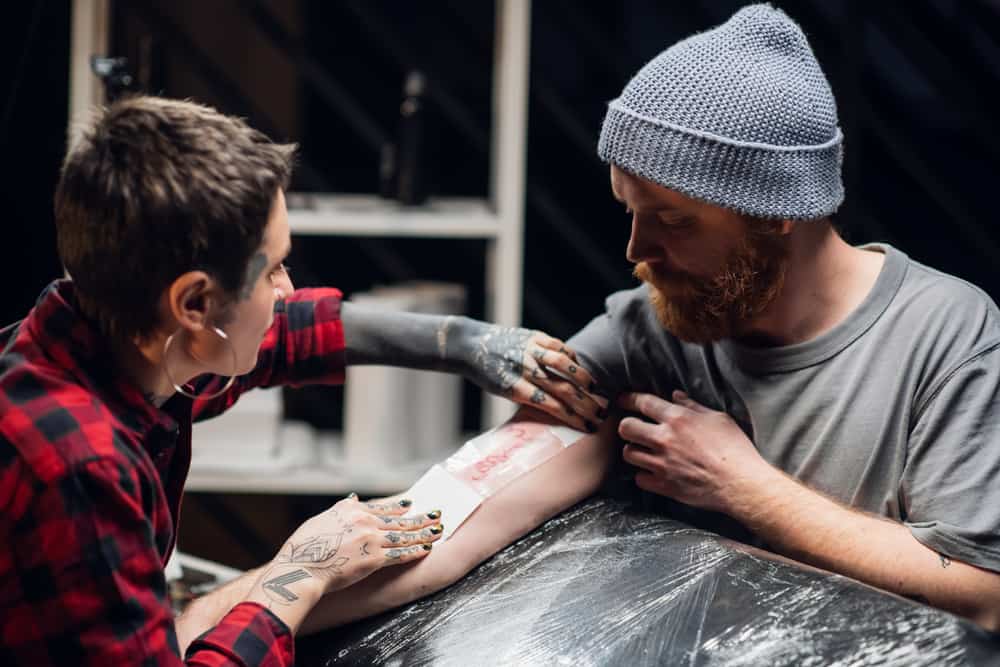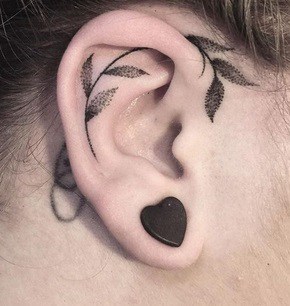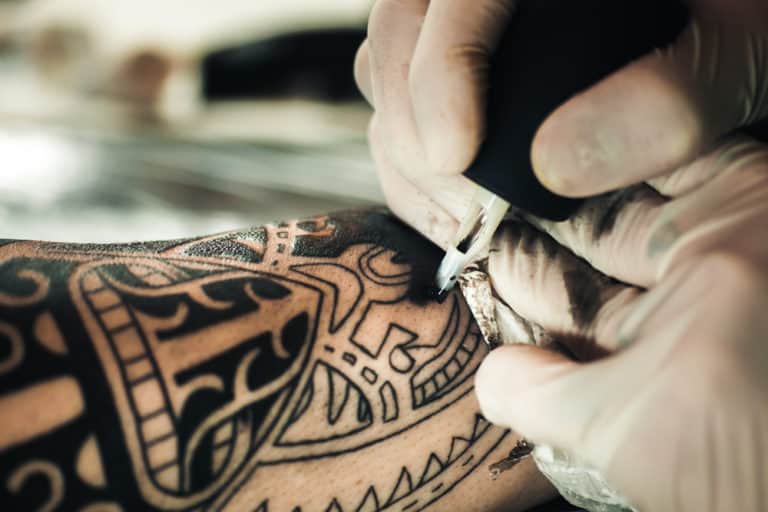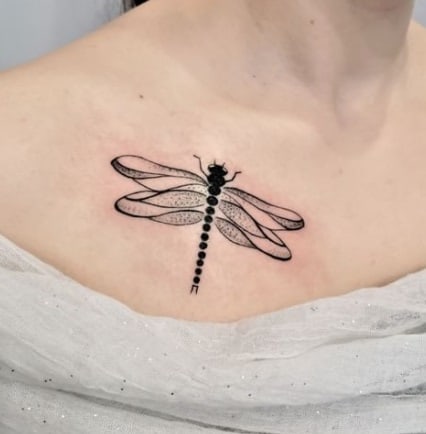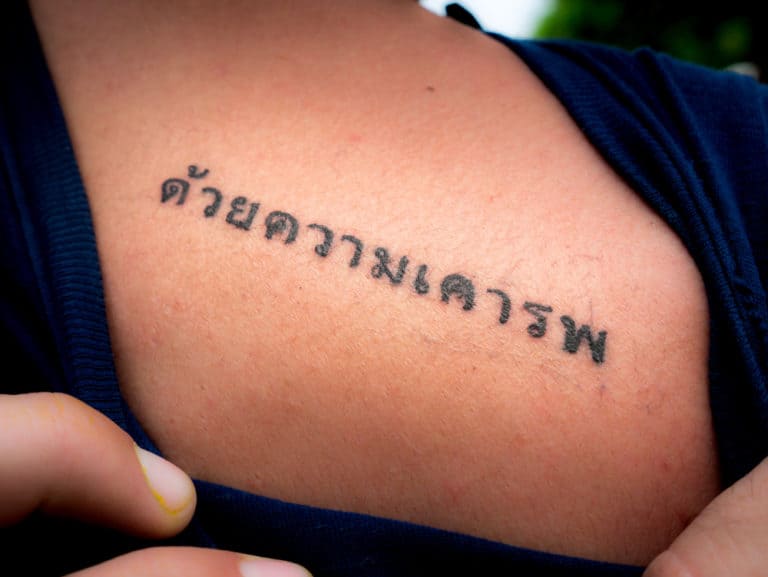Why Do Tattoo Artists Use Petroleum Jelly?
Getting a tattoo means an artist will be injecting your skin with needles and ink for several hours non-stop. If you think about that on dry skin, suddenly it sounds more like torture. With that in mind, why do tattoo artists use petroleum jelly?
Tattoo artists use petroleum jelly to minimize friction between the needles and skin and allow the needles to glide over the skin easier. It minimizes bleeding and prevents the blood from caking in the needle. Petroleum jelly is only used during the tattooing process.
Using petroleum jelly on the area that is being tattooed will lubricate the skin and minimize the pain and discomfort slightly. The petroleum jelly helps with the ink injecting into the skin and ensures the skin is supple. This helps the ink to stay vibrant and heal evenly. Let’s look at other reasons why tattoo artists use petroleum jelly.
Why Do Tattoo Artists Use Petroleum Jelly?
Tattoo artists have used petroleum jelly for decades. It was discovered to heal wounds in 1859; however, it is not recommended to use on a fresh tattoo as an aftercare treatment. Petroleum jelly remains greasy on the skin for long enough during the tattoo process.
When the area has been inked, the tattoo artist will wipe the excess petroleum jelly and the blood off to see where to ink next. The petroleum jelly also stems from the bleeding to the degree that prevents the needle from becoming blocked.
When a tattoo artist uses petroleum jelly, it makes the process easier for them and the client. Tattooing is not a painless process, so any help that doesn’t interfere with the final result is welcomed.
Is Vaseline And Petroleum Jelly The Same Thing?
Vaseline is a popular brand of petroleum jelly and is manufactured by the British company Unilever. Vaseline is 100% petroleum jelly and is a trusted brand used by most tattoo artists because of its product stability.
Vaseline is produced in plain and several scented versions. While the lavender and powder scents are appealing, it is not advisable to use any scented products on the skin as a tattoo lubricant.
Plain, unscented petroleum jelly, no matter the brand, is the best choice since there is no risk of an allergic reaction or irritation to the scents.
Petroleum Jelly And Hustle Butter – What Is The Difference?
Petroleum jelly has been around since 1859 when a chemist discovered how this greasy substance was helping heal skin wounds on the miners.
The chemist refined the petroleum grease to produce a lighter and less oily version called Vaseline through chemical processes. It was discovered to have moisturizing and healing properties and protected the skin due to its waterproof qualities.
Petroleum jelly is the by-product of petroleum which is crude oil. The main process is not environmentally friendly, unfortunately.
Hustle Butter is the complete opposite of petroleum jelly. It is an all-natural and vegan product made from shea butter and other ingredients. It is one of the best petroleum replacements on the market.
The consistency is more like butter and will become softer when applied to the skin. This well-tested product can be used on any skin type or color.
Some of the documented benefits of Hustle Butter are –
- It is non-comedogenic and Phthalate free.
- It carried a Vegan certification.
- It’s not tested on animals and cruelty-free
- Perfect as a tattoo glider
- Does not clog up the tattoo needles
- Does not fade or remove the tattoo stencil
- Allows white and yellow ink to penetrate with ease
- It can be used for tattoo aftercare
- Helps to soothe irritated skin and calms shaving rashes
How Much Petroleum Jelly Does The Tattoo Artist Use While Tattooing?
During the tattooing process, an artist can use as little as a teaspoon full of petroleum jelly or as much as a small tub, depending on the size and detail of the tattoo.
Typically the tattoo artist will begin the session by cleaning the area of skin with a minimum 70% volume alcohol swab. After cleaning, the hair will always be shaved, no matter how little or much. Shaving is crucial to prevent ingrown hairs when it heals.
Once the skin is shaved clean, the stencil is applied, and the tattooing can begin. The artist will scoop out a dollop of petroleum jelly and place it on their free hand. From there, the artist will start to apply petroleum jelly to the area that is to be first.
Most tattoo artists will use a finger to take a swab of petroleum jelly and lubricate the area before starting the process. After they have injected the ink and are happy the lines are good, they wipe off the blood and excess petroleum jelly.
How Many Times Is The Petroleum Jelly Applied During A Tattoo?
The tattoo artist will apply new petroleum jelly every couple of minutes as the tattoo process progresses. A tattoo starts with the linework and does small areas at a time, ensuring that the lines are complete before the coloring or shading process starts.
They typically do small sections at a time to prevent slipping on the skin, and it is slightly greasy and can become messy. They will repeat this process constantly until the tattoo is complete, sometimes taking 2 to 6 hours or more in one sitting.
What Are The Benefits Of Using Petroleum Jelly While Tattooing?
Petroleum jelly has proven to be beneficial to the skin in various ways. Since before it was chemically refined, miners used it to seal their skin, moisturize it and heal wounds while working underground.
Oil-based lubricants such as petroleum jelly benefit the skin while tattooing as it lessens friction and discomfort. It remains greasy for longer and helps to get the ink deposited properly.
While it is beneficial during the tattooing process, petroleum jelly should not be used as an aftercare product. It is too greasy and will prevent the skin from breathing and scabbing naturally because it locks in moisture.
While too dry skin is also not ideal, trapping moisture in the skin with petroleum jelly can create the perfect environment for a bacterial infection to develop.
Can A Tattoo Artist Use Any Other Lubricant While Tattooing?
A tattoo artist can use several different lubricants while tattooing but not all of them are ideal. Every client’s skin differs. Some have very dry or sensitive skin, some may have skin conditions like eczema or rosacea, and others have oily skin.
The main two types of lubricants a tattoo artist can use are
- Water-based lubricants like KY Jelly and Aquaphor
- Oil-based lubricants like A+D ointment, Petroleum jelly, coconut oil, baby oil, and olive oil.
Not many tattoo artists will work with a water-based lubricant. They tend to dry out faster than the oil-based lubricant and can create a sticky residue on the skin. If a water-based lubricant is used, it will have to be reapplied more times than petroleum jelly.
Water-based lubricants have a good shelf life if stored out of direct light and in an airtight tube or container. The water-based lubricants tend to retain moisture for a long time and rarely become contaminated.
Using a lubricant such as organic coconut oil could potentially be less harmful than petroleum jelly, but it would have to be certified organic and be kept sterile.
Dirty and unsanitized fingers or gloved hands should never be used to scoop out any lubricant as bacteria can contaminate the rest of the product. Bacteria such as Staph can remain in the lubricant for long.
A+D ointment has the benefit of lanolin with petroleum jelly. It can be used as a tattoo lubricant and is excellent as an aftercare product. The lanolin is derived from wool-bearing mammals such as sheep. It is water-resistant and has emollient properties for soothing skin.
Lanolin is an animal product and is not vegan. You can have a lanolin allergy if you are allergic to wool so please advise your tattoo artist beforehand.
Among other similar brands, Vaseline is a purified version of petroleum jelly that can moisturize dry skin and heal minor wounds. There were no alternatives to petroleum jelly for decades, and it was accepted as the best and cheapest tattoo glider available.
Beeswax is another popular ingredient used as a tattoo glider or lubricant. It is consistent with the tattoo butter and will contain other natural products such as shea butter to give it more viscosity.
In more recent years, vegetarian and vegan clients have been placing more pressure on several industries to become more conscious of the environmental impact of specific product manufacturing processes. This led to developing vegan-friendly tattoo gliders with shea butter and coconut oil.
Can Petroleum Jelly Cause An Infection On A Tattoo?
Petroleum jelly can become the ideal environment for several bacteria to grow. Petroleum jelly cannot grow bacteria by itself, but if unsterilized fingers are used to scoop out the jelly, it will deposit bacteria and become contaminated.
If the tattoo artist applies compromised petroleum jelly onto the skin, it can easily cause an infection later. The skin bleeds during the tattooing process, and some of the petroleum jelly will inevitably be deposited into the skin with the ink.
Also, one of the reasons petroleum jelly is not recommended for aftercare is because the skin needs to breathe, and the jelly closes the pores. It will trap moisture on the skin, and fungal or Staph infections can develop.
The correct aftercare for tattoos is crucial to prevent infection, scarring, tattoo bubbling, or bleeding. You should wash the tattooed area only as directed by the tattoo artist and apply the supplied lotion once the area is completely dry.
The lotion should be unscented and not used by anyone else. Scoop with a popsicle stick or tongue suppressor to keep it sterile.
Several dermatology authorities maintain that petroleum jelly should not be used for tattoo aftercare. Besides the infection risk, it can fade the ink.
What Happens To The Petroleum Jelly Used During The Tattoo Process?
Once the tattoo is completed, the tattoo artist will use green soap to clean the whole area thoroughly. The soap removes all the excess blood, ink, and petroleum jelly, ensuring no residue remains.
After cleaning and drying the tattoo, the artist will apply a lotion and cover it with a bandage, saran wrap, or kitchen towel. You can remove this around 4 to 6 hours later.
You can gently wash the area with soap and lukewarm water, which should further remove any traces of petroleum jelly. Press or gently tap dry the area and apply a water-based lotion. This will keep the area moisturized but not wet.
Can You Use Petroleum Jelly For Aftercare?
You may start to use petroleum jelly on your tattoo only once it is fully healed up. This can be several weeks, preferably not before a few months have passed. It would be best to let the ink settle into the skin first.
There is no valid evidence to support the use of petroleum jelly being beneficial to the skin or the tattoo, especially if evidence shows it fades tattoo ink. There are many more reasons to change to a less dense and greaseless product that is cruelty-free and good for the environment.
Again, only use non-scented lotions on the tattooed area for a good while until your skin is fully healed. The scabbing will stop after a few days to weeks, depending on how fast your body heals itself.
Conclusion
The tattoo industry is vastly different from 50 years ago and has modernized and transformed the whole process. The inks are top quality, machines become more silent, and the artworks are more vivid and intricate than ever before.
One thing that you will still find in many tattoo shops and studios is the sturdy pot of petroleum jelly. It has been the go-to tattoo glider or lubricant used on more ink than can be calculated. Many artists will continue to use petroleum jelly as long as its available, cheap and reliable.
Some of my favorite designs, tattoo books, and aftercare products, selected for you
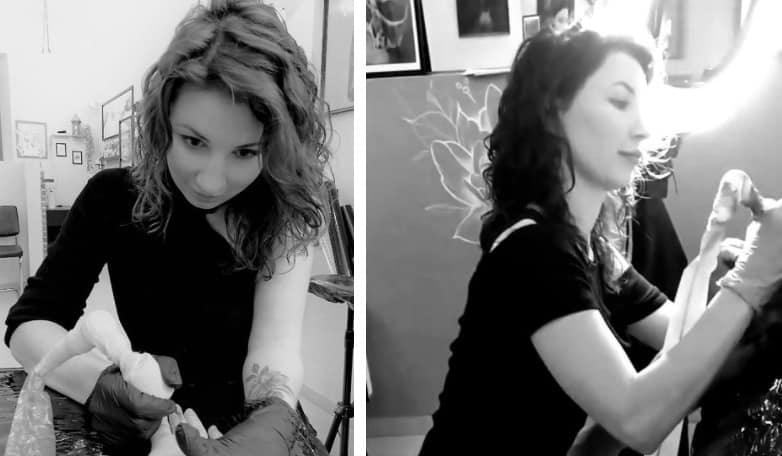
Thank you for reading my article, I hope that you have found it helpful. If you would have trouble finding ideas for your tattoo, wonder what is meaning of design that you have found or what to buy for aftercare, to make sure that your tattoo will be healing quickly and easily, here are some of my favorite products in one place, hope that this will also help.
Design and tattoo ideas
For some ideas you can have a look at those 3 books with hundreds of designs that I use with my clients, they are available on Amazon for Kindle or in classic, paper version (links below):
- Great Book of Tattoo Designs, Revised Edition: More than 500 Body Art Designs (Fox Chapel Publishing) Fantasy, Celtic, Floral, Wildlife, and Symbol Designs for the Skin by Lora Irish
- The Big Book of Small Tattoos – Vol.1: 400 small original tattoos for women and men by Roberto Gemori
- Tiny Tattoos: Over 1,000 Small Inspirational Artworks by Rebecca Vincent.
Tattoo meaning
If you would like to read more about the meaning of different tattoo styles and designs before you will decide what you would like to have, I can recommend a book that was really useful for me when I was starting my tattoo adventure – it’s “Conscious Ink: The Hidden Meaning of Tattoos” by Lisa Barretta (through the link you can find it on Amazon for around $10).
Tattoo aftercare
The skin at the tattoo site often dries out. To prevent it and speed up healing for my clients, I usually recommend one of those tattoo aftercare balms (you can find them on Amazon):

